-
Countries
-
Data and Analysis
-
Special Focus
-
Crisis Responses
Assessment Report
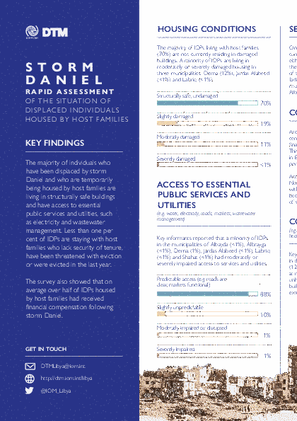
Contact
dtmlibya@iom.int
Language
English
Location
Libya
Snapshot Date
Jan 31 2024
Activity
- Other
The information included in this report is based on 56 key informant interviews which were conducted between 31 December 2023 and 05 January 2024 over the phone and in person. Informants interviewed included local elders and officials from municipal and social affairs committees, the Libyan Red Crescent Society as well as organizations for the coordination of services to displaced populations.

Contact
DTM REMAP Support Team dtmremapsupport@iom.int
Language
English
Location
Tajikistan
Period Covered
Aug 01 2023
Aug 31 2023
Activity
- Survey
- Baseline Assessment
DTM REMAP implements the Baseline Mobility Assessment (BMA) in Tajikistan to track mobility, provide information on population estimates, geographic distribution of migrant workers and return migrants, reasons for migration and countries of return. Data is collected at the village level from key informants and direct observations.
Baseline Mobility Assessment (BMA) was conducted in all five provinces and all 12 districts/cities (including Khujand and Khorugh cities, and Rudaki, Kulob, Panj, Vanj, Vahdat, Bokhtar, Firdawsi, Sino, Shohmansur and Ismoili Somoni dsitricts). This assessment covered 919 communities through 2,816 key informant interviews. Based on the key informants' estimates, 2,581 international migrant workers were hosted in the assessed communities in Tajikistan during 2020 and 2023. Concurrently, 1,900 internal migrants were hosted in the assessed communities and 247,753 Tajik nationals were reported to be residing abroad as international migrants. In addition, 121,095 return migrants have returned from abroad.

Contact
DTMUkraine@iom.int
Language
English
Location
Ukraine
Period Covered
Mar 10 2024
Apr 11 2024
Activity
- Survey
Представництво МОМ в Україні представляє Звіт про внутрішнє переміщення населення в Україні (квітень 2024 року). У цьому звіті представлені основні результати Раунду 16 Опитування загального населення (GPS), які містять найновіші репрезентативні дані про внутрішнє переміщення в Україні, що сприятимуть прийняттю обґрунтованих рішень щодо стратегічних, технічних та програмних аспектів реагування та відновлення в Україні. Збір даних проводився з 10 березня по 11 квітня 2024 року. П'ятдесят дев'ять експертів зі збору даних провели скринінгові телефонні інтерв'ю з 20 000 випадково відібраних респондентів та подальші інтерв'ю з 1 428 ВПО, 1 639 особами, що повернулася, та 2 266 особами, які не зазнали переміщення, використовуючи методологію комп'ютеризованого телефонного інтерв'ю (CATI) та метод випадкового набору номера (RDD).
Результати Раунду 16 дають детальне уявлення про чисельність населення, потоки мобільності та наміри щодо переміщення, демографічні профілі, райони переміщення та місця походження, склад домогосподарств та їхні характеристики, а також потреби переміщеного населення.

Contact
DTM DRC, iomdrcdtm@iom.int
Language
English
Location
Democratic Republic of the Congo
Period Covered
Oct 22 2023
Nov 04 2023
Activity
- Survey
The province of South Kivu is home to the third largest IDP and returnee population of any province in the DRC (1.4 million and 690 thousand individuals respectively). While the province continues to experience conflict and armed group activity, particularly in light of the ongoing M23 (Mouvement du 23 mars) crisis in North Kivu, it has been the focus of recent efforts to strengthen durable solutions programming. DTM’s latest Mobility Tracking also reflects that 49 per cent of identified returnees in the province reporting security improvement as their principal reason for return (followed by food security improvement, family reunification and economic opportunities). South Kivu is also a target province for integration in the national program for disarmament, reintegration, and stabilization (Programme de Désarmement, Démobilisation, Rélevement Communautaire et Stabilisation – PDDRCS in French). Evidence-based guidance on durable solutions and stabilization programming is essential in South Kivu, considering the close proximity of areas experiencing continuing conflict and those in a more post-crisis context.
It is in this context that the International Organization for Migration (IOM), through the Displacement Tracking Matrix (DTM), has chosen to implement the Stability Index (SI) for the first time in the DRC with the aim of identifying “pockets of stability” for targeted durable solutions programming, as well as hotspots of relative instability, with a concentration of poor and unstable living conditions, more suitable to receive humanitarian assistance. In South Kivu, DTM implemented the SI in the territories of Fizi, Kalehe and Uvira, which together host 65 per cent of all returnees in the province.
The SI assesses the relative stability of a location by evaluating three key domains: 1) Livelihoods and access to basic services, 2) Safety and Security and 3) Social cohesion, as well as information pertaining to the occurrence and impact of natural disasters, analysed separately. The SI is part of the DTM’s global Solutions and Mobility Toolkit and has been deployed successfully in diverse contexts such as Burundi, the countries of the Lake Chad basin, Ghana and Mali.
325 Villages in the territories of Fizi (118 villages), Uvira (99), and Kalehe (108) were selected for inclusion in the analysis using simple random sampling from the DTM DRC village master list, updated during the twice-yearly Mobility Tracking exercise. In the DRC, the health zone is considered the third administrative subdivision (admin-3) below territory (admin-2). As some of the villages were inaccessible due to insecurity and/or weather conditions, while others were previously de-populated, only accessible villages with population present at the time of the data collection were assessed. Due to the sampling design, data are representative at a territory level. Despite analysis and presentation of the data in this report at the health zone level, the results are representative only at the territory level), with 95 per cent confidence and a five per cent margin of error. Stability Index exercise was implemented in partnership with national non-governmental organization Réseau d’Action pour le Développement et le Progrès Intégré (RADPI) and Division Provinciale des Affaires Humanitaires (DIVAH).
Mean stability varied substantially among assessed territories (Admin 2). It was highest in Uvira and lowest in Kalehe.
Among the three territories assessed, Kalehe was found to be relatively less stable, with an average Stability Index score of 56 (out of 100), compared to Fizi (67) and Uvira (71).

Contact
DTM Sudan; dtmsudan@iom.int
Language
English
Location
Sudan
Period Covered
Feb 22 2024
Feb 28 2024
Activity
- Mobility Tracking
- Baseline Assessment
Overview
On 15 April 2023, armed clashes erupted between the Sudanese Armed Forces (SAF) and the Rapid Support Forces (RSF) in multiple cities across Sudan. Clashes initially took place in cities across Northern and Khartoum states, later spreading across the Darfur and Kordofan regions.
Highlights
- DTM Sudan estimates that 6,397,698 individuals (1,275,146 households) were recently internally displaced.
- The IDP caseload was observed in 6,890 locations across all of Sudan’s 18 states.
- The highest proportions of IDPs were observed across South Darfur (12%), River Nile (11%), and East Darfur (10%).
- Field teams reported that the IDPs observed were originally displaced from twelve states. The majority (3,556,958 IDPs, 56%) were reportedly displaced from Khartoum state; followed by South Darfur (15%), North Darfur (9%), Aj Jazirah (8%), Central Darfur (5%), West Darfur (4%), South Kordofan (2%), East Darfur (1%), West Kordofan (1%), North Kordofan (1%), Sennar (<1%) and White Nile (<1%).
- IOM-DTM also reported that an estimated 1,899,826 mixed cross-border movements were made into neighbouring countries.
- This product provides brief insights into those displaced in Sudan post-15 April 2023. For more granular information on the IDP caseload and the displacement context, please see IOM-DTM's Monthly Displacement Overview 06.
Disclaimer: Due to widespread internet and telecommunication outages, data for Aj Jazirah were last updated on 21 February 2024. Field teams were unable to submit the data for reporting until 03 March 2024.
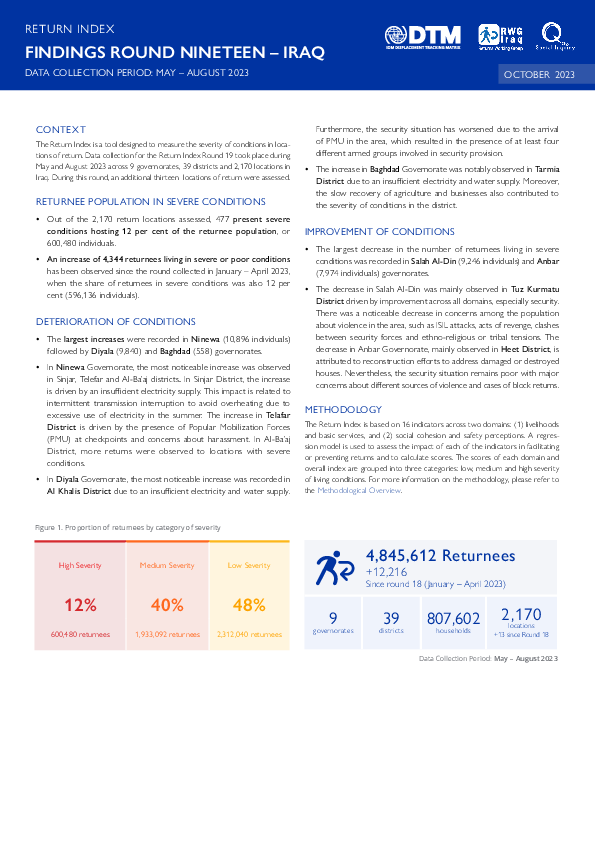
Contact
DTM Iraq, IraqDTM@iom.int
Language
English
Location
Iraq
Period Covered
May 01 2023
Aug 31 2023
Activity
- Survey
- Return Intention
- Mobility Tracking
- Baseline Assessment
The Return Index is a tool designed to measure the severity of conditions in locations of return. Data collection for the Return Index Round 19 took place during May and August 2023 across 9 governorates, 39 districts and 2,170 locations in Iraq. During this round, an additional thirteen locations of return were assessed.
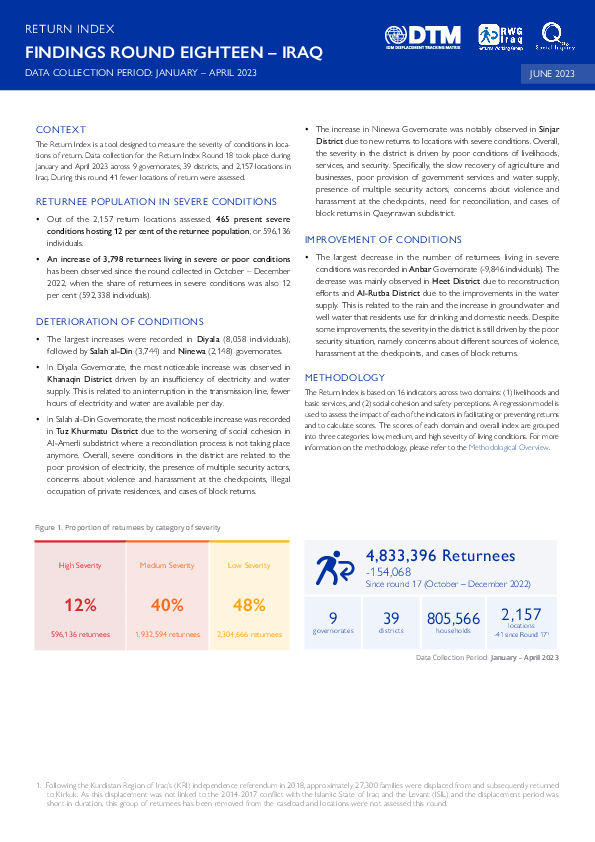
Contact
DTM Iraq, IraqDTM@iom.int
Language
English
Location
Iraq
Period Covered
Jan 01 2023
Apr 30 2023
Activity
- Survey
- Return Intention
- Mobility Tracking
- Baseline Assessment
The Return Index is a tool designed to measure the severity of conditions in locations of return. Data collection for the Return Index Round 18 took place during January and April 2023 across 9 governorates, 39 districts, and 2,157 locations in Iraq. During this round, 41 fewer locations of return were assessed.
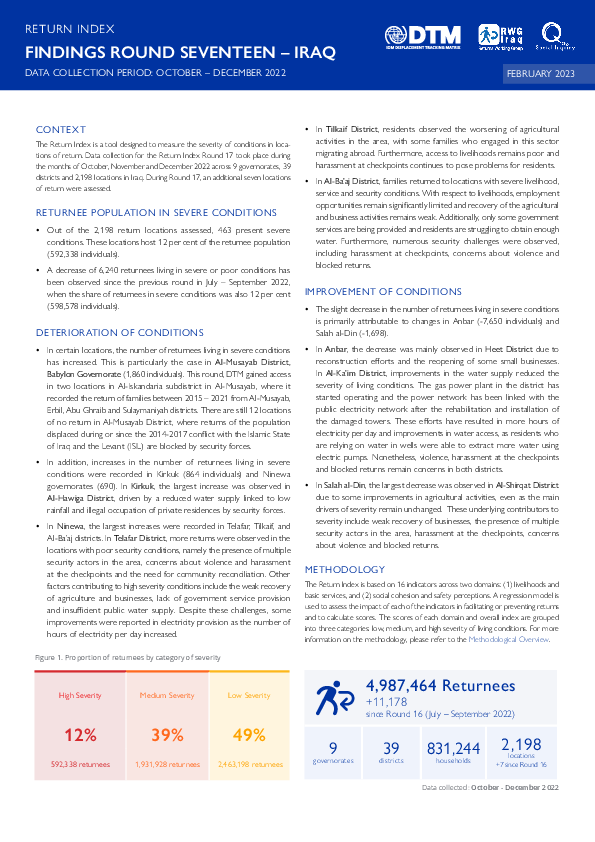
Contact
DTM Iraq, IraqDTM@iom.int
Language
English
Location
Iraq
Period Covered
Oct 01 2022
Dec 31 2022
Activity
- Survey
- Return Intention
- Mobility Tracking
- Baseline Assessment
The Return Index is a tool designed to measure the severity of conditions in locations of return. Data collection for the Return Index Round 17 took place during the months of October, November and December 2022 across 9 governorates, 39 districts and 2,198 locations in Iraq. During Round 17, an additional seven locations of return were assessed.
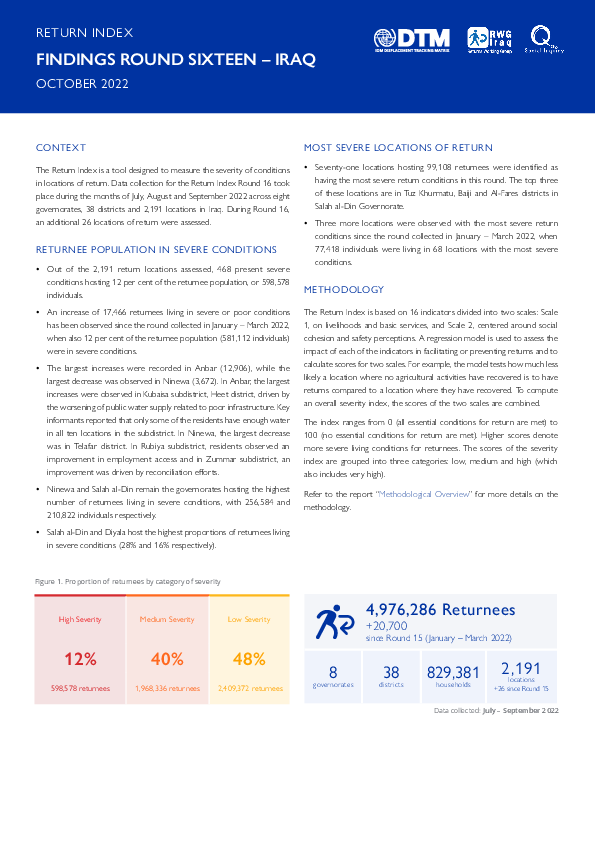
Contact
DTM Iraq, IraqDTM@iom.int
Language
English
Location
Iraq
Period Covered
Jul 01 2022
Sep 30 2022
Activity
- Survey
- Return Intention
- Mobility Tracking
- Baseline Assessment
The Return Index is a tool designed to measure the severity of conditions in locations of return. Data collection for the Return Index Round 16 took place during the months of July, August and September 2022 across eight governorates, 38 districts and 2,191 locations in Iraq. During Round 16, an additional 26 locations of return were assessed.
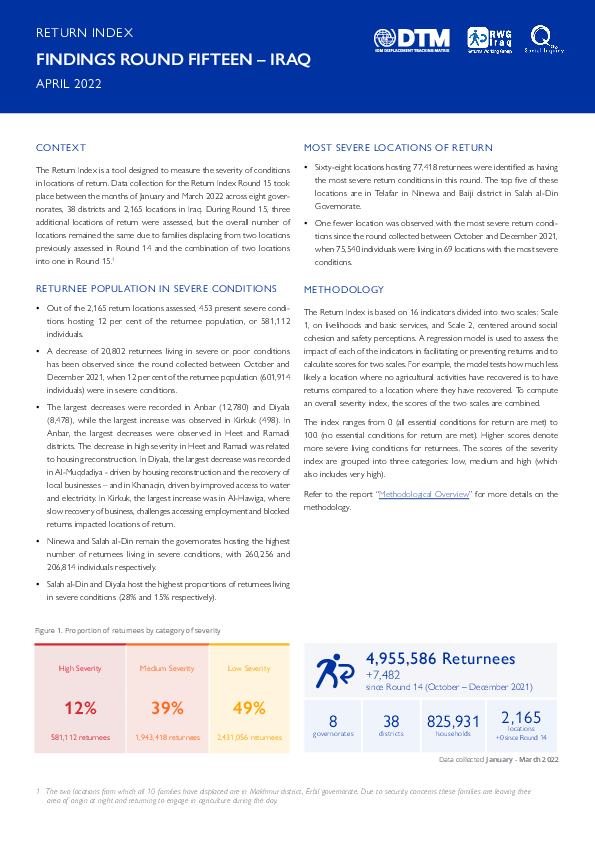
Contact
DTM Iraq, IraqDTM@iom.int
Language
English
Location
Iraq
Period Covered
Jan 01 2022
Mar 31 2022
Activity
- Survey
- Return Intention
- Mobility Tracking
- Baseline Assessment
The Return Index is a tool designed to measure the severity of conditions in locations of return. Data collection for the Return Index Round 15 took place between the months of January and March 2022 across eight governorates, 38 districts and 2,165 locations in Iraq. During Round 15, three additional locations of return were assessed, but the overall number of locations remained the same due to families displacing from two locations previously assessed in Round 14 and the combination of two locations into one in Round 15.
Pagination
- Previous page
- Page 46
- Next page
